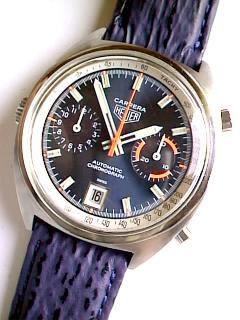 Heuer Carrera Chronographs:
Heuer Carrera Chronographs:
 - A
Brief Overview: Then, Now and the
Future:
|
- A
collaboration between
- Matthias
Liebe-Kleymann
 & Chuck
Maddox
& Chuck
Maddox

- Based on
a thread from 19 June
2002,
- Last
Revised: 18 May 2003, 11:12
GMT.
- Certain
Rights Reserved.
|
- Top,
In
The
Beginning,
- The
1960s,
The
1970s,
- The
1980s,
The
1990s,
- Now
and the future...
- Addendum,
Author's
Notes,
- Certain
Rights Reserved
|
- Click
here to go to Part 2: The
1960's
-
-
|
|
|
After 1969, while Heuer
continued to produce and market manual wind and
even quartz models, the main thrust of their
efforts were with the newly introduced automatic
movement Cal. 11/12 and later the Cal 15 was
used.
Here is here how Heuer
introduced the new Carrera in
advertisement:
|
|
|

|
|
|
|
Well, truth is that
Heuer didn't really “move” the crown.
The Calibre 11 family was the first modular
chronograph construction: a chronograph module
made by Dubois-Depraz was attached to a
Büren micro-rotor movement. To fit, the
chronograph plate had to be rotated by 180
degrees. So the strange placement of crown and
pushers was a technical necessity and not a
tribute to the self-winding feature. So it was a
change made out of necessity, not
choice.
Jeff
Stein, an avid Heuer collector, and as of
February 13 2003 the owner of OnTheDash.com
website discovered the "beta" version of this
article and was kind enough to send the
following scans for inclusion for this
article:

|
|
--
click on the picture to open a full
sized version of this picture in a new
window...
|

|
|
--
click on the picture to open a full
sized version of this picture in a new
window...
|
|
|
|
Special thanks to Jeff Stein for his
contribution to this article. I feel it
adds greatly!
|
|
|
A search of information available on the race
for the first automatic chronograph reveals
several very useful articles available on the
Internet. So we will not repeat those efforts in
this article. Three very good articles are:
1969,
World First Automatic
Chronograph
by Boon (no email address provided),
The
Race for the First Auto-Chrono
Movement
by Ignacio,
and Christoph Ozdoba's
A
Brief History of the Automatic
Chronograph.
A recent Heuer Valjoux
7750 acquisition by Chuck yielded a Heuer
Automatic Chronograph Instruction Manual which
covers both Heuer Valjoux 7750 Movement
Chronographs and Micro-Rotor Movements. A portal
to a web page with scans of this document
follows:
- Heuer
Automatic Chronograph Instruction
Manual:
- The
English language text begins on page 3 with a
diagram for use with the Micro-Rotor movement
on page 12.
Here are a couple of
micro-rotor Carreras gleaned from the
net:
|
|
|

|
|

|
- Calibre
12
|
|
Two
shots of a Calibre 12
Carrera
|
|
|

|
|

|
|
Another
Calibre 12
|
|
Second
Shot
|
-
|
- One of the
interesting things about Heuer is
that since they were seemingly
always experimenting with the looks
of their watches either they
innovated many things or were so
quickly adaptable to perceived
trends, oftentimes it becomes
muddled as to who truly was first
out there with an innovation. In
addition to the aforementioned
uncertainty with the honor of having
announced the first automatic
chronograph wristwatch movement, we
also have a very early example of
PVD coated Stainless
Steel...
|
|
|

|

|
|
At this point
it remains unclear who was the first
producer of a "Black Watch"... Heuer or
Porsche Design/Orfina…
|
|
|
|

|
|
Matthias'
Calibre 15 Carrera
|
|
|

|
Perhaps
the ugliest "Carrera" in
captivity!
|
|
Definitely
Coyote-Ugly!,
and most certainly a
Frankenwatch...
|
|
|
|

|
A
Cal 12 movement (Although it's in
Matthias' Heuer
Montreal)
|
|
The
four different types of Micro-Rotor
Movements…
|
|
Calibre:
|
Description:
|
|
c.11
|
first
member of the family with a 19,800
hourly beat rate, only in production
for one year - (two register: 30
min-counter, 12 hour counter, date, no
sweep second)
|
|
c.12
|
better
winding system, 21,600 beat rate (same
layout as the c.11)
|
|
c.14
|
c.12
with with additional GMT
hand
|
|
c.15
|
with
sweep second in place of 12 hour
counter.
|
|
|
|
Note:
|
There
is no Cal 13, perhaps because in many
parts of the world the number 13 is
regarded an "unlucky
number"...
|
|
Click
here to go to Part 4: The
1980's
|
|
|
Permission for
personal, educational or non-commercial use is
granted as long as this notice and the document
remains intact and unaltered. The authors retain
all other rights not specifically mentioned
here... For all other use please contact the
authors.
Disclaimer: Opinions are
our own and knowing us should be taken with a grain
or two of salt...
|
|
|
|